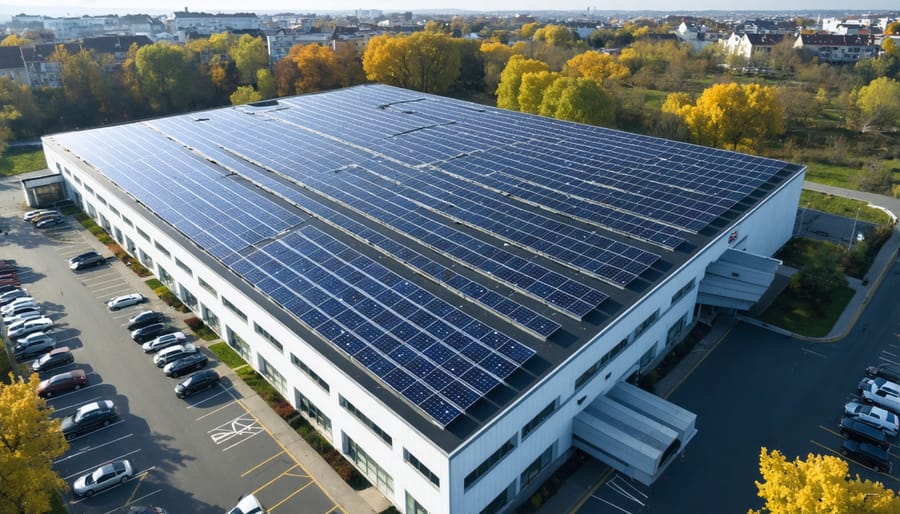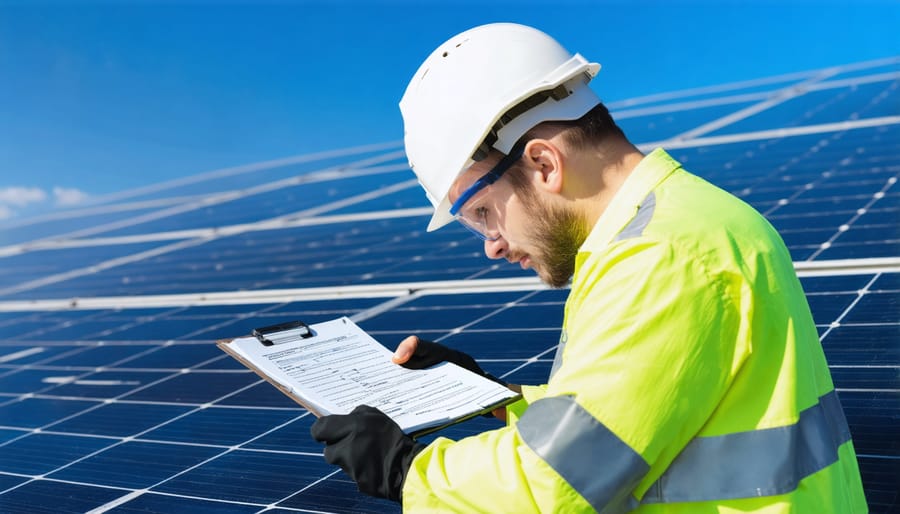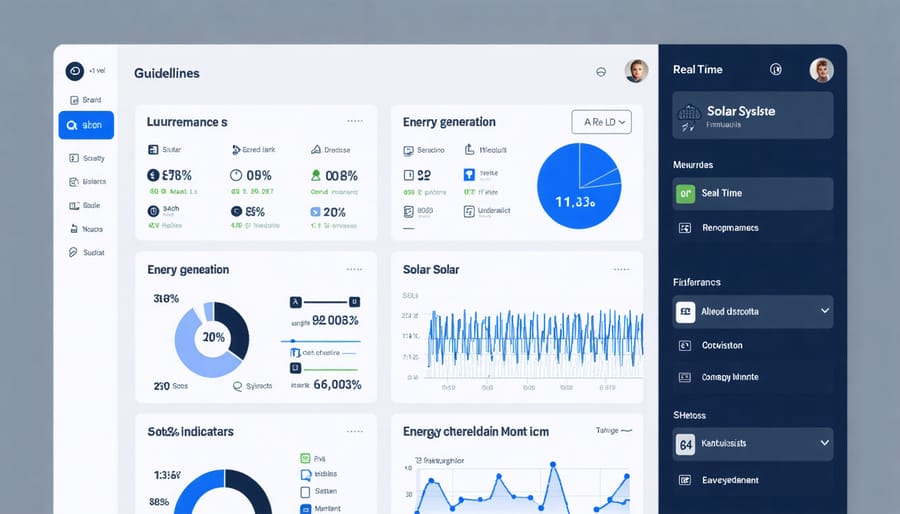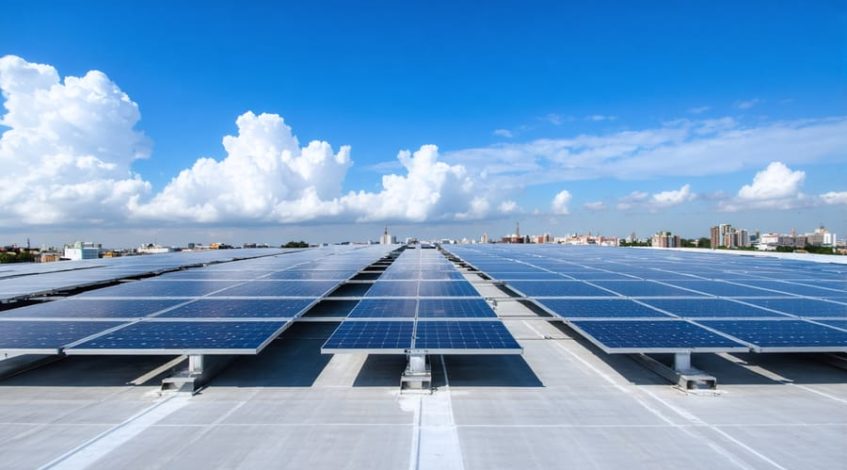Photovoltaic systems represent a transformative investment in modern energy infrastructure, delivering unparalleled operational autonomy and financial returns for forward-thinking organizations. As global energy demands intensify and sustainability becomes a strategic imperative, PV technologies have emerged as a cornerstone of corporate energy strategies, offering measurable advantages that extend far beyond basic power generation. Through advanced semiconductor materials and sophisticated power conversion systems, today’s photovoltaic installations achieve peak efficiency rates exceeding 20%, while requiring minimal maintenance and generating zero operational emissions. This technological maturity, combined with dramatic cost reductions in solar panel manufacturing, has positioned PV systems as a compelling solution for businesses seeking to optimize their energy expenditure while strengthening their environmental credentials. The scalability and adaptability of modern photovoltaic arrays enable organizations to precisely match their energy generation capacity with current needs while maintaining the flexibility to expand as demands grow.
Operational Flexibility and Scalability
Modular Design Benefits
One of the most significant advantages of photovoltaic systems lies in their modular design architecture. This characteristic allows organizations to start with a base installation and systematically expand their solar capacity as needs grow or budgets permit. Business owners can initially install a system that meets their current energy requirements and later add additional panels without disrupting existing operations.
The modular nature of PV systems also provides flexibility in system configuration. Panels can be arranged in various layouts to maximize available space and optimize energy generation based on site-specific conditions. For instance, a manufacturing facility might start with rooftop installations and later expand to parking canopies or ground-mounted arrays as energy demands increase.
This scalability proves particularly valuable for growing businesses, as it enables strategic capital allocation and phased implementation of solar infrastructure. Facility managers can easily replace individual panels or inverters without compromising the entire system’s functionality, ensuring minimal downtime during maintenance or upgrades. This approach also allows organizations to incorporate newer, more efficient solar technologies as they become available, keeping their energy systems current with technological advancements.

Integration with Existing Infrastructure
A significant advantage of photovoltaic systems lies in their remarkable ability to integrate with existing building infrastructure. Modern PV installations can be seamlessly incorporated into both new construction and retrofit projects without requiring extensive modifications to current electrical systems. The modular nature of solar panels allows for flexible installation options, whether on rooftops, parking structures, or ground-mounted arrays, maximizing available space while maintaining building functionality.
These systems can work in parallel with conventional power sources, enabling a hybrid approach that ensures reliable energy supply. The integration process typically involves installing inverters and monitoring systems that communicate with existing building management systems (BMS), creating a cohesive energy management solution. This compatibility extends to smart building technologies, allowing facility managers to optimize energy consumption through automated controls and real-time monitoring.
For commercial properties, PV systems can be integrated with existing HVAC systems and emergency power supplies, creating a comprehensive energy management strategy. The installation process can be phased to minimize disruption to daily operations, making it an attractive option for businesses seeking to transition to renewable energy without compromising operational efficiency.
Minimal Maintenance Requirements

Long-Term Reliability
Photovoltaic systems demonstrate exceptional longevity, with modern solar panels typically maintaining over 80% of their initial power output capacity even after 25 years of continuous operation. This remarkable durability is achieved through advanced manufacturing techniques and robust materials, including tempered glass and weather-resistant aluminum frames that protect against harsh environmental conditions. Quality solar installations routinely exceed their warranty periods, with many systems continuing to generate significant power for 30-35 years.
The solid-state nature of PV technology means there are no moving parts to wear out or replace, significantly reducing maintenance requirements and associated costs. Most systems only require occasional cleaning and basic electrical inspections to maintain optimal performance. This inherent reliability makes photovoltaic systems particularly attractive for commercial applications, where long-term operational stability is crucial for ROI calculations and facility planning. Leading manufacturers now offer performance guarantees backed by extensive testing and field validation data, providing investors with confidence in system longevity.
Predictable Maintenance Schedules
Photovoltaic systems stand out for their predictable maintenance requirements, making them highly attractive for business operations. Unlike conventional power systems with complex moving parts, solar panels primarily need basic cleaning and annual inspections. Typical maintenance involves removing dust and debris, checking electrical connections, and monitoring system performance through integrated software solutions.
The maintenance costs are notably lower compared to traditional energy systems, typically ranging from 0.5% to 1% of the initial system cost annually. Most manufacturers recommend bi-annual professional inspections, with daily operations requiring minimal oversight. Modern monitoring systems can automatically detect performance issues, allowing for proactive maintenance scheduling.
For commercial installations, this predictability enables accurate budget forecasting and reduces unexpected downtime. Many facilities report maintenance intervals of 6-12 months, with most tasks completed within a single day, minimizing operational disruptions and maintaining consistent energy production levels.
Advanced Monitoring and Control
Real-Time Performance Tracking
Modern photovoltaic systems come equipped with advanced monitoring capabilities that provide unprecedented visibility into system performance. These sophisticated monitoring platforms collect and analyze real-time data on energy production, consumption patterns, and system efficiency. Facility managers can access detailed performance metrics through user-friendly dashboards, enabling immediate identification of production anomalies or maintenance requirements.
The integration of smart sensors and IoT technology allows for granular tracking of individual panel performance, weather impact analysis, and predictive maintenance scheduling. This data-driven approach helps organizations optimize their energy usage, forecast future production, and maximize their return on investment. Performance tracking systems can also generate automated reports, making it easier to document energy savings and verify renewable energy credits.
System alerts and notifications ensure rapid response to potential issues, minimizing downtime and maintaining optimal energy generation levels. This proactive monitoring approach has been shown to increase system efficiency by up to 20% compared to unmonitored installations, directly impacting bottom-line savings and environmental benefits.

Remote Management Capabilities
Modern photovoltaic systems offer sophisticated remote management capabilities that enhance operational efficiency and system performance. Through advanced monitoring platforms, facility managers can access real-time data, track energy production, and identify potential issues from any location with internet connectivity. These smart monitoring systems provide detailed analytics on energy generation patterns, environmental conditions, and system health metrics.
System operators can remotely adjust settings, optimize performance parameters, and implement preventive maintenance protocols without physical site visits. Automated alerts notify stakeholders about performance anomalies, enabling swift response to potential problems. This proactive approach significantly reduces downtime and maintenance costs while maximizing energy yield.
Cloud-based management platforms integrate with building management systems, allowing for seamless coordination of energy resources. Facility managers can analyze historical performance data, generate comprehensive reports, and make data-driven decisions to enhance system efficiency. Additionally, remote troubleshooting capabilities enable technical support teams to diagnose and often resolve issues remotely, minimizing the need for on-site service calls and reducing operational expenses.
ROI and Financial Benefits
Energy Cost Reduction
One of the most compelling advantages of photovoltaic systems is their potential for significant energy cost reduction. Organizations implementing PV systems typically experience a substantial decrease in their electricity bills, with many reporting savings of 50-75% on their monthly energy expenses. These commercial energy ROI benefits become particularly evident within 5-7 years of installation.
The cost-saving mechanism operates on multiple levels. First, businesses generate their own electricity during peak sunlight hours, reducing dependence on grid power when rates are typically highest. Second, many regions offer net metering programs, allowing organizations to sell excess power back to the grid, creating an additional revenue stream. Third, the declining costs of PV technology, coupled with improved efficiency ratings, have significantly reduced initial investment requirements.
Modern photovoltaic systems also offer predictable energy costs, enabling better long-term financial planning. While traditional electricity rates continue to rise annually, solar-generated power costs remain stable after the initial investment. Organizations can effectively lock in their electricity rates for 25-30 years, the typical lifespan of quality PV systems. This predictability provides a crucial advantage in budgeting and resource allocation, particularly for energy-intensive operations.
Government Incentives and Tax Benefits
Government support for photovoltaic systems represents a significant financial advantage for businesses and organizations considering solar energy adoption. The federal Investment Tax Credit (ITC) allows organizations to deduct up to 30% of their solar installation costs from their federal taxes, substantially reducing the initial investment burden. This credit applies to both commercial and industrial installations, making it a powerful incentive for large-scale deployments.
Many states offer additional tax incentives, grants, and rebate programs that can be combined with federal benefits. These may include property tax exemptions for solar installations, sales tax exemptions on equipment purchases, and performance-based incentives that reward energy production. Some jurisdictions also provide accelerated depreciation schedules, allowing businesses to recover their solar investments more quickly through tax deductions.
Net metering policies, available in numerous states, enable organizations to receive credits for excess energy fed back into the grid, creating additional cost savings. Some utilities offer specific solar-friendly rate structures and incentive programs that can further enhance the financial benefits of PV system ownership.
Local governments frequently provide additional support through green building incentives, expedited permitting processes, and renewable energy certificates (RECs). These programs, combined with federal and state incentives, can significantly reduce the payback period and improve the overall return on investment for photovoltaic installations.
Photovoltaic systems represent a strategic investment that delivers multiple advantages for forward-thinking organizations. From substantial energy cost savings and reliable power generation to enhanced environmental stewardship, PV technology offers a compelling value proposition. The minimal maintenance requirements, long system lifespan, and steady technological improvements continue to make solar power an increasingly attractive option for businesses of all sizes. As energy costs rise and environmental regulations tighten, organizations that embrace photovoltaic solutions position themselves for long-term success while demonstrating leadership in sustainability. By carefully evaluating their energy needs and working with qualified solar providers, businesses can develop customized PV solutions that optimize their return on investment while contributing to a cleaner, more sustainable future. The time is right for organizations to explore how photovoltaic systems can benefit their operations and bottom line.

